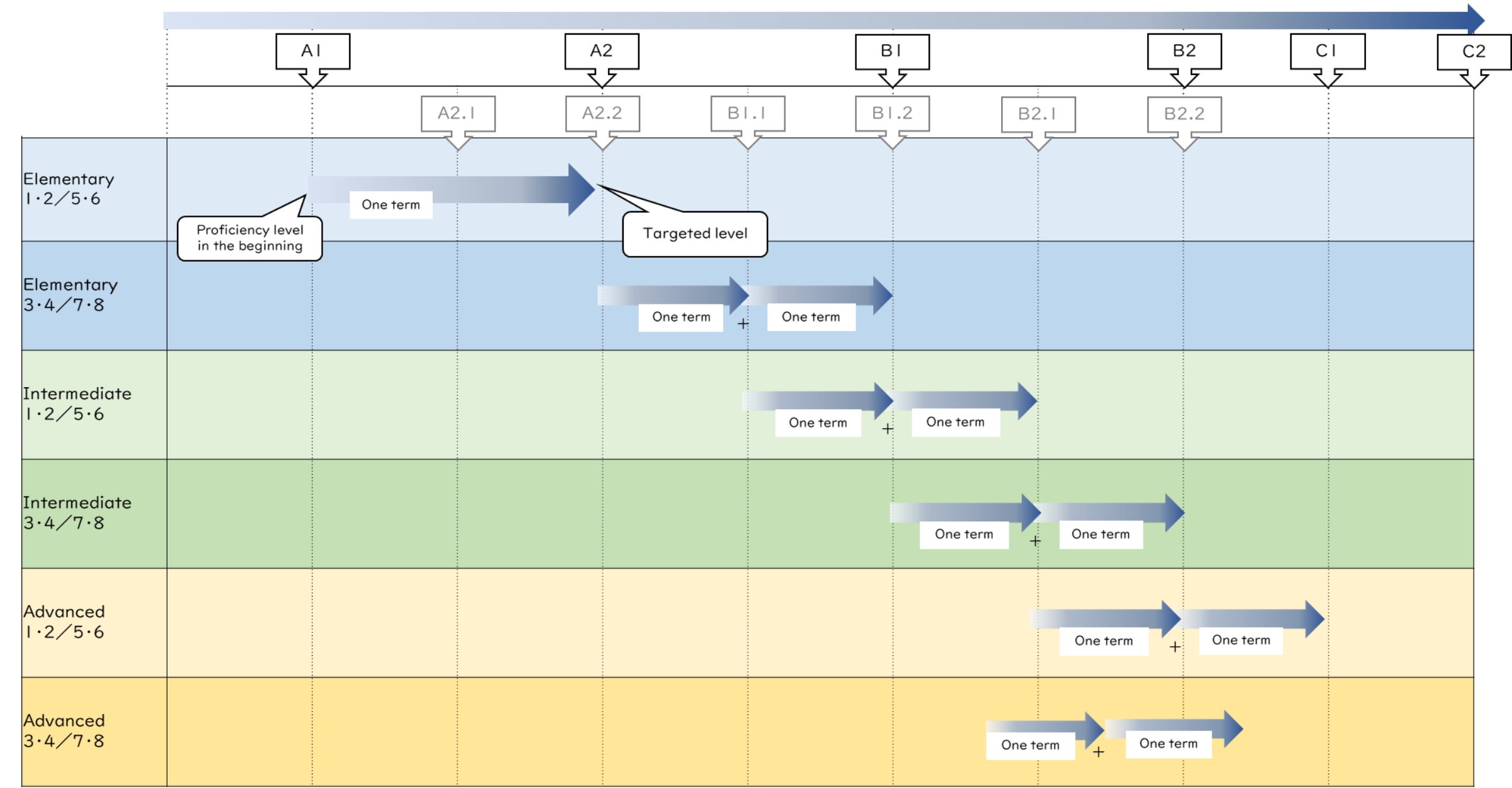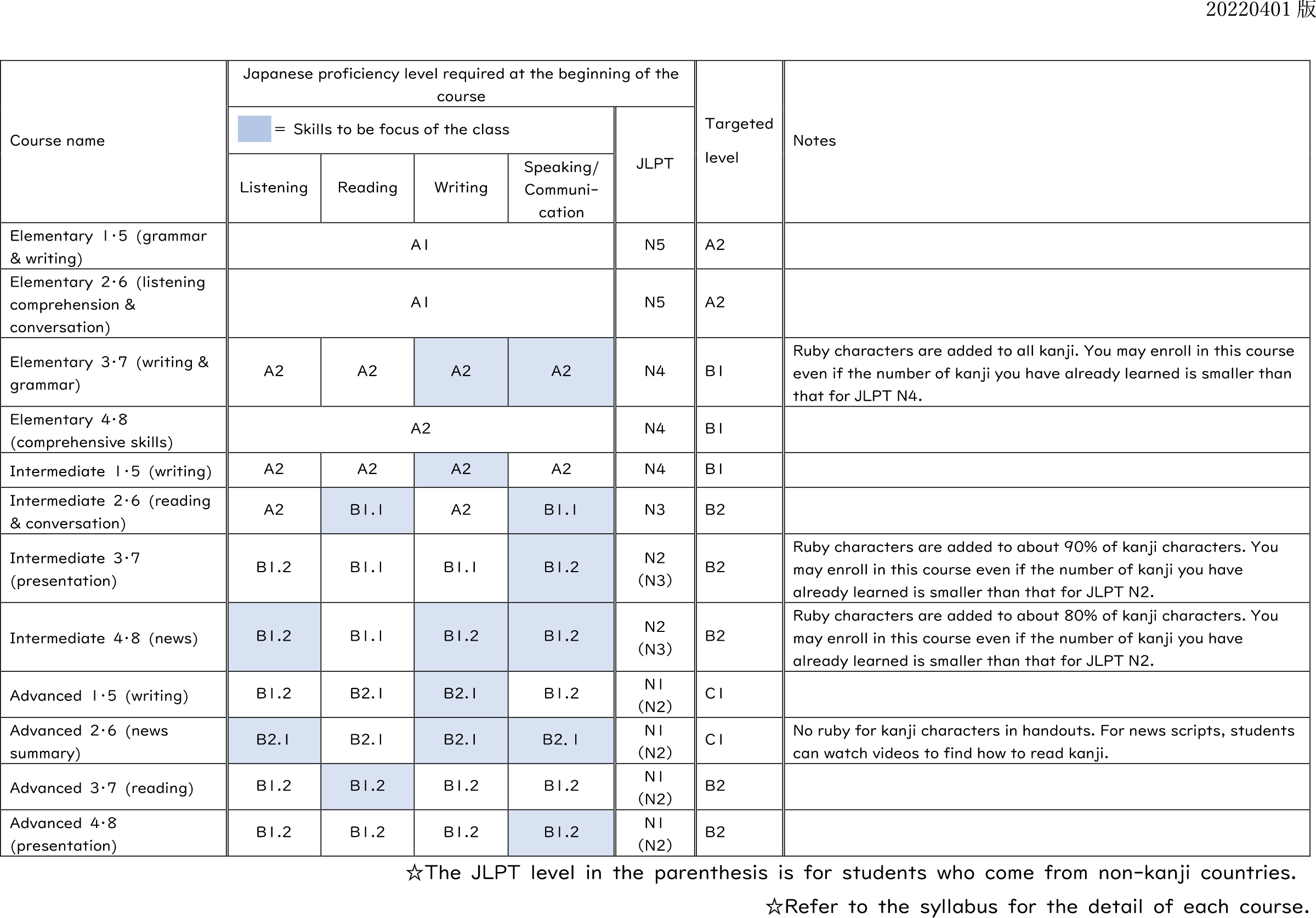Japanese CoursesGlobal

"Japanese language" courses offered by Gakushuin University's Foreign Language Teaching and Research Centre
The Foreign Language Teaching and Research Centre offers a total of 12 courses (elementary, intermediate and advanced) in each term, with Courses #1-4 for the first (spring) term and # 5-8 for the second (fall) term. The CEFR-based level of each course is shown in the chart and table below.
To enlarge, click here (Japanese courses.pdf).


Basic points
- There are three levels of Japanese language courses: elementary, intermediate, and advanced.
- You can earn one (1) credit by taking each course.
- Students who wish to take a Japanese course as an elective should contact the Foreign Language Teaching and Research Centre in advance and ask for permission.
- You can take both elementary and intermediate courses at the same time.
- You can take both intermediate and advanced courses at the same time.
- The courses numbered 1 through 4 are offered in the first (spring) term and 5 through 8 are in the second (fall) term.
- For exchange students, we usually give a placement test to decide which courses each of them should take. When we do not give the test, we refer to the language proficiency statement in the application document to assign them to an appropriate level of courses.
Below are the outlines of the Japanese language courses at each level.
Elementary courses
- Assuming that enrolled students can read and write hiragana, katakana, and about 50 kanji (Chinese characters), the Japanese elementary courses aim to help students acquire the minimum level of Japanese language proficiency required to live daily life by learning basic vocabulary, grammar and kanji. (Learning goals: 1,500 Japanese words, basic sentence patterns, 300 kanji characters)
- Elementary courses are designed mainly for exchange students. Privately-funded students may be able to be enrolled in these courses as an elective if they have received permission from the instructor in advance.
Elementary #1 & 5 Grammar and writing
| Course description | These courses mainly introduce Japanese grammar, and how to read and write Japanese sentences, to students having the CEFR (Common European Framework of Reference for Languages) A1 level of reading, writing, listening and speaking skills. Additionally, students may practice listening and speaking. |
|---|---|
| Course objectives | At the end of the courses, participants are expected to understand grammatical structures, which is necessary to have a simple daily conversation. |
Intermediate #2 & 6 Reading comprehension and conversation
| Course description | These courses mainly introduce how to listen and speak in Japanese to students having the CEFR A1 level of reading, writing, listening and speaking skills. Additionally, students may learn Japanese grammar, reading and writing. |
|---|---|
| Course objectives | At the end of the courses, participants are expected to understand words and expressions frequently used in daily life, and have acquired skills to talk about themselves, to ask others about personal things and to discuss about simple topics. |
Elementary #3 & 7 Writing and grammar
| Course description | These courses mainly aim to help students having the CEFR A2 level of reading, writing, listening and speaking skills further improve their reading and writing fluency. No special exercise is provided for listening and speaking, but participants are given many opportunities to listen and speak Japanese in class. |
|---|---|
| Course objectives | At the end of the courses, participants are expected to use elementary-level grammatical knowledge to write about a variety of topics. They should also be able to use kanji characters in writing sentences and to use MS Word to write texts. |
Elementary #4 & 8 From elementary to intermediate level
| Course description | Using comprehensive course materials for reading, writing and speaking, these courses, which are designed for students at the CEFR A2 level, aim to help participants read 1,500-character texts, go over grammar rules they have learned, and talk and write about some topics. |
|---|---|
| Course objectives | At the end of this course, participants are expected to use the CEFR A2/B1 level of vocabulary and grammatical knowledge to speak and write in Japanese. |
Intermediate courses
- Intermediate courses aim to help students acquire language skills sufficient to lead daily life, to have a general conversation, and to understand simple sentences. (Learning goals: 6,000 Japanese words, slightly higher level of grammar, 1,000 kanji characters)
Intermediate #1 & 5 Writing sentences
| Course description | These courses introduce how to write sentences in Japanese to students having the CEFR A2 level of language skills. |
|---|---|
| Course objectives | At the end of these courses, participants are expected to acquire the CEFR B1 level of writing proficiency. |
Intermediate #2 & 6 Reading comprehension and conversation
| Course description | Taking up different topics, these courses aim to give students opportunities to read texts, put together their own opinions, and have discussions. |
|---|---|
| Course objectives | At the end of these courses, participants are expected to read sentences on various topics and to put together and express their thoughts in Japanese. They are also expected to be able to listen to others, ask questions and exchange opinions. |
Intermediate #3 & 7 Presentation
| Course description | These courses aim to give opportunities to practice speaking and listening in Japanese to students having the CEFR B1.1 level of reading and writing skills and the CEFR B1.2 level of listening and speaking skills. No special exercise for reading and writing will be provided although students will need to read and write in Japanese in preparation for their presentations. |
|---|---|
| Course objectives | At the end of these courses, participants are expected to be able to use expressions and follow grammatical rules to prepare for a presentation. They should also be able to do research about topics of their interest and to share their own opinions. In addition, enrolled students are expected to be able to engage in Q&A sessions with other students after their own presentations. |
Intermediate #4 & 8 News
| Course description | These courses aim to give opportunities to listen and write in Japanese to students having the CEFR B1.1 level of reading skills and the CEFR B1.2 level of listening, speaking and writing skills. No special exercise for reading and speaking will be provided although students will have group discussions in class every week. |
|---|---|
| Course objectives | At the end of the courses, participants are expected to understand the content of a 2 to 3-minute news report and to be able to understand and apply expressions used in a news report. They should also be able to exchange opinions in Japanese about news items and to write a report about their discussions in class. |
Advanced courses
- Advanced courses aim to help students learn how to use Japanese language in a variety of complex situations. Participants also acquire Japanese language skills required in academic contexts, such as seminar presentations and report writing. (Learning goals: more than 10,000 Japanese words, advanced grammar, and more than 2,000 kanji characters)
Advanced #1 & 5 Writing
| Course description | These courses aim to give opportunities to write in Japanese to students having the CEFR B2.2 level of listening, reading, speaking and writing skills. No special exercise for reading, listening and speaking will be provided although students will use these skills in doing assignments and having group discussions. |
|---|---|
| Course objectives | At the end of the courses, participants are expected to be able to write sentences to express yourself to others properly and to write sentences appropriate for each situation. |
Advanced #2 & 6 Summarizing news pieces
| Course description | These courses aim to give opportunities to practice listening, writing and speaking to students having the CEFR B2.2 level of language skills. No special exercise will be given for reading although students will sometimes have to read texts to do assignments. |
|---|---|
| Course objectives | At the end of these courses, participants are expected to understand the content of a 10-minute news segment after watching it, demonstrating that they have acquired listening comprehension skills to participate in lectures and seminars at the university level. Students are also expected to be able to make a few-page effective summary of a news piece they have watched. They should also be able to answer questions in an appropriate manner, referring to the summary they have made. |
Advanced #3 & 7 Reading materials about different themes
| Course description | These courses aim to help students at the CEFR B1 level learn advanced-level kanji, vocabulary and technical terms by reading newspaper articles and/or slightly academic essays in publishers' PR magazines (#3) and articles about scientific, sociological, economic, historical and global issues (#7). Participants will also express their views in writing about the materials. |
|---|---|
| Course objectives | At the end of the courses, participants are expected to have reading skills at/above the CEFR B2 level. |
Advanced #4 & 8 "Reading" about a movie (#4); Think about various issues (#8)
| Course description | In these courses, students do research and make a presentation on various issues described in movies. They learn how to make a PowerPoint presentation and a summary (#4). Students having the CEFR B2 level of language skills have discussions about issues that have no definitive answer and summarize their views in writing (#8). |
|---|---|
| Course objectives | At the end of the courses, participants are expected to make a presentation in the CEFR B2 level of Japanese (#4). They are also expected to be able to express themselves and write their opinions in the B1 level of Japanese (#8). |
Recommend
For Prospective Exchange Students






